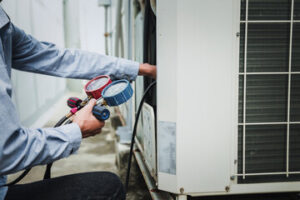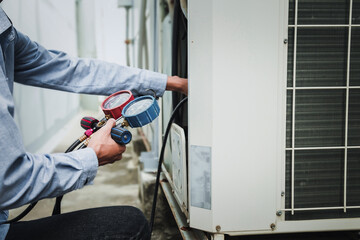AC Repair Van Nuys is the process of fixing and restoring functionality to a malfunctioning or damaged air conditioning system. While each AC unit requires a unique approach to service, the general method involves inspecting the system, servicing what needs servicing, and making any repairs necessary.
Many common issues can be resolved without the need for a professional, saving you money and getting your system back up and running quickly. Here are some tips to help you get started.
A thermostat is like the brain of an air conditioner, so a problem with it can affect your entire system. Luckily, you can try a few quick troubleshooting steps before calling in an AC repair professional.
If your thermostat display is dark, it may mean the unit has no power. This is often caused by a dead battery, so be sure to replace them. If that doesn’t work, check for a blown fuse or tripped breaker in the electrical panel. If you find a problem, turn off the thermostat’s breaker and remove the cover to look at the internal components. Use canned air or a soft artist brush to clean away any accumulated grime that could be affecting the thermostat’s functionality. Then, you can carefully examine the connections and terminal screws to make sure they’re tightened.
Another common thermostat issue is when it doesn’t accurately sense the temperature in your home. This is usually a sign that the unit is not mounted in the correct location or in direct sunlight, which can cause it to read warmer temperatures than the actual ambient air. If you’re concerned about this, it’s best to have a professional remount your thermostat to ensure that it is reading accurate temperature data.
It’s also important to check the wire connections in your thermostat. If they’re corroded, loose, or disconnected, this can interfere with the fan motor and cause it to short-cycle frequently. This puts a lot of stress on the compressor and can eventually lead to its premature failure. This is one of the reasons why it’s so important to have a trained and certified professional perform any HVAC installation or repairs in your home.
Faulty Compressor
The compressor is a crucial part of your air conditioner. If you have a problem with it, the whole system will be affected. This is because the compressor is responsible for circulating the refrigerant and sending it to the condenser coil, so it’s vital that it is working properly.
One of the biggest signs that your AC compressor is faulty is when it fails to engage with the pulley when you switch it on. This will usually result in a screeching or whining noise. It can also cause your AC system to stop cooling, or it may produce warmer air than usual.
Another sign of a failing compressor is when it constantly trips your circuit breaker. This can occur because the compressor is overheating and drawing too much power. Rather than continuously resetting the circuit breaker, it’s better to call an HVAC professional to look at the issue. This way, the underlying problem won’t worsen and become a fire hazard.
You might also notice puddles or water leaking from your compressor unit. This can happen if the compressor isn’t getting enough oil, or it has a clogged condenser unit. A clogged condenser unit can lead to a compressor failure, so it’s best to call an HVAC professional for a preventative maintenance check.
Finally, if your compressor is making a chattering sound when it starts up, this is a sign that the internal bearings are failing or that the compressor is not operating properly. It could also be caused by a mismatched suction line, which can build pressure and overheat the compressor. An experienced HVAC technician will know the right length of suction line to install for your particular compressor unit.
Faulty Fan Motor
The fan motor is the part of the air conditioning unit that circulates the cooled air throughout your home. If this component becomes damaged or breaks, it may not be able to function properly, which could cause your air conditioner to stop working. The main sign of a problem with the fan motor is when the airflow stops flowing from your vents. A professional technician will be able to examine the motor and determine what is causing it to break.
Another possible sign of a faulty fan motor is if you hear a rattling sound. This can be caused by unbalanced or loose fan blades hitting the fan housing cage, or by other issues that make it difficult for the fan to turn. If the fan motor isn’t working, you won’t be able to cool your home effectively, so you should call a specialist right away.
A breaker that frequently trips is usually a sign of a problem with the capacitor, which provides a charge of electricity to start up the fan motor. If this capacitor fails, the air conditioning system won’t start and you’ll have to replace it. You should never attempt to remove or fix a capacitor on your own because the electrical charge that runs through it can cause shocks and even fires. An experienced technician will know how to handle a capacitor safely and efficiently.
If your capacitor does fail, you’ll likely need to replace the fan motor as well. You can do a simple test to check the condition of your AC fan motor by using a multimeter with the ohms setting. Touch the probes to two of the motor terminals. If you get an infinite reading, the motor is faulty.
Faulty Condenser Coil
Your AC’s condenser coil releases heat into the outside air, and when this part isn’t working, it prevents your system from cooling the air properly. Fortunately, there are a few steps you can take to get things in working order again. First, check to see if it’s clogged with debris or vegetation that may be impeding its ability to cool your home.
Alternatively, your condenser coil could have significant leaks within its tubes and seals. While these can sometimes be repaired, replacing the entire component is usually a more cost-effective option.
If your condenser is leaking fluid, it’s likely because of the same kind of problems that may have caused your compressor to fail – damage from heavy use and age. Fortunately, you can have a professional clean your condenser to remove the debris and dirt that can cause leaks.
Another common problem that can affect the operation of your AC unit is a dead relay switch. These switches energize your fan motors and compressor, so when they die, it can prevent your system from turning on. Replacing this part is a relatively easy fix for a trained technician.
The final common issue that can impact your AC’s performance is a faulty condensate drain line. Moisture that your AC absorbs through the process of condensation needs to move through a condensate drain pipe into the sewer or septic tank. If this pipe becomes blocked or damaged, you will need a professional to unclog it and repair the pipe before the water overflows into your home. Getting your condensate drain line cleaned by a professional is a simple service that should be done as part of your regular maintenance services.
Faulty Thermostat
If your air conditioning unit keeps turning itself on and off, it could be because of a faulty thermostat. A thermostat that constantly tries to cool your home or heat it up can lead to excessive energy bills. It can also cause the breaker in your electrical panel to trip. This can damage the breaker and require that it be replaced. Changing the batteries in your thermostat may help this problem. It is also a good idea to clean the thermostat. Using canned air or a soft artist’s brush can help eliminate dust and debris that has accumulated.
Another symptom of a faulty thermostat is when it does not display the correct room temperature. This is because the thermostat has a sensor inside that reads the temperature of the air in the room and signals the system to turn on or off based on this reading. If the sensor is not functioning properly, the thermostat won’t correctly signal the system to turn on or off.
A faulty thermostat can also trigger frequent short cycling. This is because it can be unlevel or dirty, which causes the anticipator arm to incorrectly calibrate. The best way to fix this issue is to level the thermostat or clean it thoroughly.
Sometimes, the drain line for an AC unit can get clogged with debris or mold. This can lead to water damage to ceilings, walls, and other parts of the house. Fortunately, the AC unit has a safety mechanism called a float switch that will shut off the unit to prevent water damage. However, this is a sign that the float switch in the thermostat needs to be cleaned or replaced.

